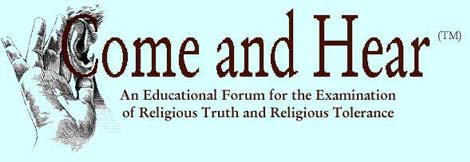The Roadmap
4. Structure of the Talmud Files

The Roadmap — Let the Rabbis tell us about the Talmud. Why is this fundamental book of Judaism unknown to most Americans?
| Navigate This Site | |
 | |
| Home | |
| Valentine | |
| Dilling | |
| Talmud | |
| The Rabbis | |
| Supplement | |
| Glossary | |
| Download | |
| Admin | |
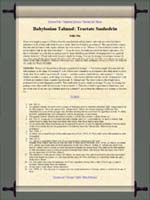
Babylonian Talmud page as it appears on Come and Hear™. Each page contains a complete folio, sides 'a' and 'b' with footnotes.

1961 Soncino Talmud from the editor's collection.
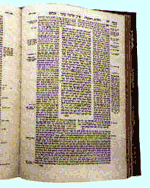
A page from a Hebrew Talmud. Note the concentric divisions of text.
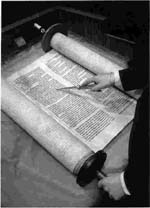
A Scholar discusses the text in a religious scroll.
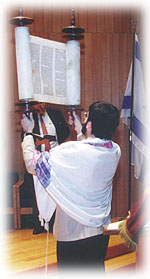
A student holds a Judaic religious scroll.
The Talmud is divided into six major sections, called sedarim (plural of seder, "order"). This is the sequence of the sedarim in the Soncino Talmud:
- Seder Zeraim (seeds)
- Seder Moed (festivals)
- Seder Nashim (women)
- Seder Nezikin (damages)
- Seder Kodashim (sacrifices)
- Seder Tohoroth (cleanness)
Each Seder contains between seven and twelve tractates, or books. To see that structure, go to the page, Contents of the Soncino Babylonian Talmud. As you will see, some of the tractates are hot linked. Clicking on any of those tractates will take you to the introductory page for the tractate (e.g., introductory page for the Tractate Sanhedrin).
The introductory page contains the translator's introduction to the tractate. Each tractate is composed of numbered chapters.
The Soncino Talmud contains three types of text: Mishnah, Gemara (for definitions, see More Critical Words of Talmud Law), and footnotes. Most tractates have all three. The Mishnah and Gemara sections are clearly labeled, and of course the footnotes are obvious.
- MISHNAH — The written rendition of "Oral Law."
- GEMARA — The Gemara follows the Mishnah. Some tractates contain no Gemara. There may be many cycles of Mishnah and Gemara within a chapter.
- Footnotes — According to Rabbi Dr. Isidore Epstein in his "Introduction to Seder Nezikin," the footnotes were written by renowned Talmudic scholars to clarify the course of the arguments, allusions, and technical expressions. Most of the Talmud is heavily footnoted. Throughout the Talmud text on this web site, the text is hot-linked directly to the corresponding footnote. Clicking on a footnote reference moves the browser to the footnote section.
Thus, the structure of the Talmud, with some exceptions, is as follows:
TalmudSEDERTractateMore sedersChapterMore tractatesMishnahMore chapters
Gemara
Footnotes
Folios
One further physical division of the Talmud is most important for the student to understand. Each tractate is physically divided into folios, corresponding to the physical leaves of paper of the Vilna Edition, printed by the Romm family in Lithuania in the 1800s. As with a page in an English book, a folio may start or end in the middle of a sentence. An average folio may span about ten printed pages in the Soncino edition. Folios are numbered, and further subdivided into "a" and "b." Thus, a Talmud passage can be unambiguously cited as "Sanhedrin 18b." In our discussions, we will always use this tractate/folio system when citing the Talmud.
Some commentators do not use the Vilna standard when citing Talmud passages. Instead, they use the tractate, chapter, and Mishnah number. Thus, in Tractate Sanhedrin, Chapter 6, the first Mishnah could be cited as "Sanhedrin 6:1". This is less common, but it is sometimes used among people who take exception to the Vilna printing.
On Come and Hear™, to keep the files small enough for slow modems, each folio is coded as a separate file. Thus Sanhedrin 18a and 18b is one file.
Tractate Introductory Page
The introductory page for each tractate contains the title page information and the Contents with links to the associated forwards and introductions, links to chapters within the tractate, and links to the individual folios.
The translator's introduction (on the same page) usually contains a summary of each chapter.
Footnote Renumbering
The 1961 printing of the Soncino Talmud (from which this presentation was scanned) numbered the footnotes at the bottom of each printed page, starting with the number (1). For this hypertext version, the footnotes have been renumbered. For further explanation, see below.
Search Engine
It was not possible to put the Soncino General Index into hypertext. As a second best, Come and Hear™ provides a number of search engines as a substitute.
- Pico Search, for use on the Internet. When using Pico Search the user will be able to search on
- the entire Come and Hear™ site
- the Carol Valentine section
- the Elizabeth Dilling section
- the Talmud (Tractates: Sanhedrin, Berakoth, Shabbath, Yebamoth, Kethuboth, Nedarim, Nazir, Sotah, Gittin, Baba Kamma, Baba Mezi'a, Baba Bathra, Abodah Zarah, Horayoth, Niddah, and Tohoroth)
- the rabbinical commentary and supplementary material section
- Google, for use on the Internet after Google finds and scans the Come and Hear™ site. For the reader's convenience, we have provided an interface to Google that restricts the results to the Come and Hear™ site.
- Fish and Fumble, for use on a local file system copy or CD of Come and Hear™. Fish and Fumble is relatively crude, but still of some use. We are working to find a better system for the CD version.
File Format for the Talmud Pages
As mentioned above, to keep the files small enough for slow modems, each folio pair has been coded as a separate file. The file format is illustrated using the folio Sanhedrin 18. The features of that model file are numbered in green, and explained in the following numbered notes.
- Useful hot-links:
- Previous folio - Preceding text in this book ("tractate").
- Sanhedrin Directory - Introductory page for the current tractate, containing the introduction to the tractate, a direct link to each of the chapters, and a direct link to each of the folios.
- Tractate List - List of all the Talmud seders and books.
- Navigate Site - Central access to all the features of Come and Hear™
- "Babylonian Talmud" and name of tractate (in this case, "Sanhedrin").
- Number of the current folio (in this case, 18), part 'a'.
- Text of the Mishnah and/or Gemara. In this case, the folio begins with Gemara text continued from the previous folio. Note that each numbered footnote reference is hot-linked to the applicable note. Clicking on the reference brings the applicable note to the top of the screen.
- Chapter heading. Note that it appears partway through the folio. Chapters can span many folios.
- Mishnah text.
- Gemara text.
- Hot link to Part 'b' of the folio.
- Footnotes for part 'a'.
The 1961 printing of the Soncino Talmud (from which this presentation was scanned) numbered the footnotes at the bottom of each printed page, starting with the number (1). Consequently, the Soncino editors use page numbers when cross-referencing to text and other footnotes. For example, Sanhedrin 18a, note 26 refers to "p. 92, n. 4." Such a schema is not meaningful in the web format because we have no "pages."
Moving the text from printed page to hypertext had other consequences. For example, page 90 of the printed Sanhedrin contains text from folios 17b and 18a, and the appropriate footnotes: footnotes (1) through (6) pertain to the text of 17b, and footnotes (7) through (11) pertain to the text of 18a.
The folio 18a spans pages 90, 91, 92, and part of 93. With each new page, the footnotes begin at (1). Thus, within any given folio in the printed Soncino Sanhedrin, there are multiple footnotes with the same numbers.
In putting the Talmud on the web with one folio per page, we needed a unique number for each footnote, and this required us to renumber the footnotes. In current form, each folio starts with Footnote (1) and numbers sequentially to the end of the folio.
In no way is this hypertext Talmud intended to replace the printed Soncino Talmud — nor could it. Our purpose is to help Rabbi Sacks achieve his goal that we find out about each others' faiths. The hypertext herein is intended to provide easily accessible context for discussions of the Talmud. - Useful hot-links:
- Tractate List - List of all the Talmud seders and books.
- Glossary - The Soncino Glossary (with some additions, indicated in green).
- Search - Search Engine page.
- Bible Reference - Hot link to online Bible service with a variety of translations.
- Part 'b' of the current folio.
- Text of the Mishnah and/or Gemara. In this case, the folio begins with Gemara text continued from the previous folio.
- Hot link to the next folio in the tractate.
- Footnotes for part 'b'. See comments for part 'a' footnotes, above.
The Come and Hear Talmud files contain two other features that should be described. When Talmud text is cited in the Elizabeth Dilling' The Jewish Religion: Its Influence Today, or a page is reproduced in her book as an exhibit, we have inserted a tag in the left margin of the Talmud text, and hot-linked it to the Dilling commentary. Further, the text that is underlined in Dilling's exhibit is highlighted in blue in the tractate file. Examples of this usage can be seen in Gittin 57a.
When a footnote is underlined or quoted in the Dilling commentary, the footnote text is highlighted in blue and the numbered reference in the Talmud text is highlighted in violet.
Examples of all of these features appear in the folio Gittin 57a, and a model Talmud files is shown in an illustration the Appendix.
One other feature that may be of interest: Rabbi Rodkinson, in his New Edition of the Babylonian Talmud, left out sections of the Talmud text. In Do Not Censor the Talmud, Please, we discuss some of those omissions, and underline the missing text for the reader's convenience. An example can be seen at Shabbath 118b.
Thank you for your consideration of the above,
Carol A. Valentine, [email protected]
July 14, 2003 ( This article is on line at http://www.come-and-hear.com/structure.html )
|
Navigate Carol Valentine's America Under the Talmud — Will It Work for US? | |||||
 Howdy! |
 Starting Out |
 Censorship |
 Death Penalty |
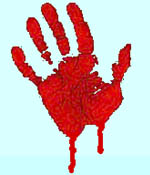 Blood Ritual |
 New America |
| Navigate This Site | |
 | |
| Home | |
| Valentine | |
| Dilling | |
| Talmud | |
| The Rabbis | |
| Supplement | |
| Glossary | |
| Download | |
| Admin | |
Endnotes:
- This and other Come and Hear™ Studies on Talmudic Judaism can be found online:
- http://www.come-and-hear.com/editor
- The Jewish Religion: Its Influence Today by Elizabeth Dilling, complete with all 300 exhibits, can be found online:
- http://www.come-and-hear.com/dilling
- Soncino Babylonian Talmud tractates, with Forewords, Introductions, Glossary, List of Abbreviations, and footnotes. Now you can study the Babylonian Talmud in full context and with the running commentary of the finest scholars of Judaism:
- Tractate Berakoth: http://www.come-and-hear.com/berakoth
- Tractate Shabbath: http://www.come-and-hear.com/shabbath
- Tractate Yebamoth: http://www.come-and-hear.com/yebamoth
- Tractate Kethuboth: http://www.come-and-hear.com/kethuboth
- Tractate Nedarim: http://www.come-and-hear.com/nedarim
- Tractate Nazir: http://www.come-and-hear.com/nazir
- Tractate Sotah: http://www.come-and-hear.com/sotah
- Tractate Gittin: http://www.come-and-hear.com/gittin
- Tractate Baba Kamma: http://www.come-and-hear.com/babakamma
- Tractate Baba Mezi'a: http://www.come-and-hear.com/babamezia
- Tractate Baba Bathra: http://www.come-and-hear.com/bababathra
- Tractate Sanhedrin: http://www.come-and-hear.com/sanhedrin
- Tractate Abodah Zarah: http://www.come-and-hear.com/zarah
- Tractate Horayoth: http://www.come-and-hear.com/horayoth
- Tractate Tohoroth: http://www.come-and-hear.com/tohoroth
- Search the Talmud http://www.come-and-hear.com/tindex.html
- Download all the above resources for local study, CD, or mirror web site:
- http://www.come-and-hear.com/download.html
